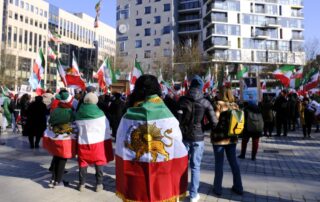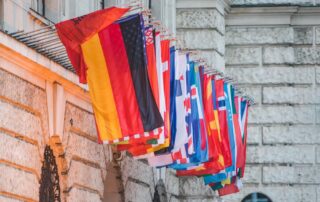
In the nearly year and a half since Russia first invaded Ukraine, much has shifted in the European bloc as it responds and adapts to the conflict occurring in its own backyard. Russia’s apparent commitment to continuing the war has prompted many members of the bloc to ask themselves what could come next, and if Europe could soon also be at war. Aside from rising military tensions and political pressure among NATO and the European Union, Europeans must also contend with energy supply issues and recessions as they navigate their new normal.
Sweeping EU sanctions against Russian giant Gazprom and other entities have sent energy prices soaring over the past year and a half, sometimes reaching prices 15 times higher than those recorded in 2021, leaving European consumers scrambling to rearrange budgets in order to afford the bills. Although the energy crisis has calmed since the past winter, when the situation was at its most precarious due to high demand and discussion of energy rations, the shock of the ordeal has prompted European countries to re-examine their energy sources and adjust accordingly, especially as a recession threatens to strain the bloc further.
The recession in Europe is a direct result of the sanctions imposed upon Russian gas imports in the EU. In an effort to curb Russia’s spending capacity, the EU has sanctioned nearly 90 percent of its oil imports from Russia, which previously supplied approximately half of the EU’s total oil imports. In an effort to offset the impact of the sanctions on the average consumer, the EU also committed to subsidizing some energy costs through redistributing increased profits made by energy companies off of the high prices. These drastic sanctions paired with the payouts, though effective, caused considerable instability in the bloc as Germany and France, the two largest consumers of oil in the EU clambered to find alternative sources of oil and natural gas.
Germany, the largest economy in the EU, announced a recession earlier this year in the wake of a 0.3 percent shrinkage in economic output during the first months of 2023, which exacerbates the 0.5 percent shrinkage experienced during the last months of 2022. As a result of the downturn, many consumers have tightened their spending and it is forecasted that private consumption will drop 1.7 percent before the end of the year, with Germany’s GDP also forecast to grow 1.5 percent, as opposed to the 1.7 percent that was originally forecast for the year. Further exacerbating Germany’s recession is its exports market, which was crippled by the sanctions imposed on Russia. German industry had to limit production at the end of last year due to increased natural gas prices, which previously had been supplied by Russia. As a result, Germany’s exports dropped by 5.2 percent in March. Unfortunately, Germany’s lagging economy will likely pose a threat to the wellbeing of the Eurozone. With no strong rebound in sight for Germany, the Eurozone, which otherwise was able to avoid economic catastrophe over the winter, may be hindered in its growth moving forward.
Despite the woes in Germany, the energy crisis brought about by the war in Ukraine has some bright spots. Importantly, the European bloc has pivoted almost entirely away from the chokehold Russia had previously exercised over the EU energy market. Now, most of the EU’s oil and natural gas imports come from Norway, Texas, and Qatar and Germany, which previously had no facilities to store liquified natural gas, has led the charge in swiftly building holding terminals to aid in storage and distribution.

The Netherlands and other countries have followed suit, suggesting a long term commitment to energy diversification as well as to localizing energy production and storage, which in turn could bolster the European economy. Furthermore, the EU is on track to outpace its natural gas storage goals. In March 2023, storage was at 55 percent capacity, which is nearly 25 percent more than it was in March 2022.
Beyond oil and natural gas, Europe has turned its attention to wind, solar, nuclear, and hydro- power as potential options for diversifying its energy sources. In 2022 nearly 40 percent of electricity generation in the EU was a result of renewable energy sources. France leads the EU in nuclear energy production, with more than half of its energy production sourced from nuclear plants. Spain provides an example of successful wind generation, with 32 percent of its electricity in 2022 stemming from wind. Solar power also generated nearly a quarter of the EU’s electricity in 2022, contributing to the EU’s first year when renewable energy outpaced fossil fuels for energy production. Hydropower also plays a significant role in the EU’s renewable energy production.
Approximately 70 percent of the hydropower in the EU is supplied by 5 countries: Austria, France, Italy, Spain, and Sweden. Although there have been some snags in the EU’s abrupt pivot to renewable energy, such as unprecedented drought and the phase out of Germany’s last nuclear plants (although use of these had been extended in order to stabilize energy costs in light of the war in Ukraine) as part of a 2011 initiative to eliminate nuclear power in the country, the EU has accomplished a tremendous feat in transitioning so quickly and efficiently to greener energy sources from fossil fuels and Russian oil.
Despite minor recessions in Germany and slow growth across the EU, prospects are much more positive than they seemed this time last year. The EU seems to have avoided a catastrophic energy crises and successfully established itself as a self-sufficient entity separate from Russian oil and gas that prioritizes green energy and renewable fuel. US businesses in the oil and gas sectors may see opportunities in Europe opening up as Russia continues to be hit with sanctions.
Further opportunities may present themselves for businesses in the renewable energy sector. China, for example, stood to make a profit on their inexpensive solar panels in the recent push to become independent from Russian gas - an opportunity US and other European businesses could also capitalize. On the flip side, with China’s economy ramping back up, Europe will face steeper competition for liquified natural gas - a main source of energy in Asia. For exporters of LNG in the US, this could be a boon. For now, the world can breathe as the worst case scenarios of the European energy crises seem to have been averted, and indeed, growth both in European and American business may well be on the horizon, especially in the energy sector.
The recent energy sector crisis in the EU has opened up opportunities for new suppliers and innovative solutions. This presents investment opportunities for companies in several sectors, particularly for companies in the green energy space.
It will be important to keep a pulse on the energy situation as the EU heads into the 2023 winter season. The seasonal increase in the demand for energy will test the emerging strategies that EU member states have put in place. This dynamic may also force quicker decision making in terms of selecting new energy suppliers.
If you are considering entering the EU energy market, there are important regulatory requirements to consider along with an increasingly complex geopolitical risk landscape in the region.
Infortal Worldwide offers a full suite of due diligence investigation services that can place your company in a much stronger position to move forward with foreign investment plans. This includes vetting any potential partners for business risk exposure, reputational and regulatory concerns. Our due diligence methodology also covers screening for sanctions risks, which is critical in the energy space.
Infortal Worldwide can help protect your investment from unnecessary risk and avoid reputational damage in the marketplace.




